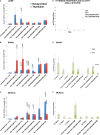Deoxypyrimidine monophosphate bypass therapy for thymidine kinase 2 deficiency
- PMID: 24968719
- PMCID: PMC4154130
- DOI: 10.15252/emmm.201404092
Deoxypyrimidine monophosphate bypass therapy for thymidine kinase 2 deficiency
Abstract
Autosomal recessive mutations in the thymidine kinase 2 gene (TK2) cause mitochondrial DNA depletion, multiple deletions, or both due to loss of TK2 enzyme activity and ensuing unbalanced deoxynucleotide triphosphate (dNTP) pools. To bypass Tk2 deficiency, we administered deoxycytidine and deoxythymidine monophosphates (dCMP+dTMP) to the Tk2 H126N (Tk2(-/-)) knock-in mouse model from postnatal day 4, when mutant mice are phenotypically normal, but biochemically affected. Assessment of 13-day-old Tk2(-/-) mice treated with dCMP+dTMP 200 mg/kg/day each (Tk2(-/-200dCMP/) (dTMP)) demonstrated that in mutant animals, the compounds raise dTTP concentrations, increase levels of mtDNA, ameliorate defects of mitochondrial respiratory chain enzymes, and significantly prolong their lifespan (34 days with treatment versus 13 days untreated). A second trial of dCMP+dTMP each at 400 mg/kg/day showed even greater phenotypic and biochemical improvements. In conclusion, dCMP/dTMP supplementation is the first effective pharmacologic treatment for Tk2 deficiency.
Keywords: deoxycytidine monophosphate; deoxythymidine monophosphate; encephalomyopathy; therapy; thymidine kinase.
© 2014 The Authors. Published under the terms of the CC BY 4.0 license.
Figures







References
-
- Bourdon A, Minai L, Serre V, Jais JP, Sarzi E, Aubert S, Chretien D, de Lonlay P, Paquis-Flucklinger V, Arakawa H, et al. Mutation of RRM2B, encoding p53-controlled ribonucleotide reductase (p53R2), causes severe mitochondrial DNA depletion. Nat Genet. 2007;39:776–780. - PubMed
-
- Bulst S, Abicht A, Holinski-Feder E, Muller-Ziermann S, Koehler U, Thirion C, Walter MC, Stewart JD, Chinnery PF, Lochmuller H, et al. In vitro supplementation with dAMP/dGMP leads to partial restoration of mtDNA levels in mitochondrial depletion syndromes. Hum Mol Genet. 2009;18:1590–1599. - PubMed
Publication types
MeSH terms
Substances
Grants and funding
LinkOut - more resources
Full Text Sources
Other Literature Sources
Medical
Molecular Biology Databases

